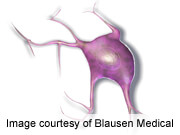Hypervigilance Critical for Difficult-to-Detect Melanoma
Source: Doctors Lounge, July 2014

Source: Doctors Lounge
TUESDAY, July 1, 2014 (HealthDay News) — Monitoring patients at extreme risk with total-body photography (TBP) and sequential digital dermoscopy imaging (SDDI) assists with early diagnosis of primary melanoma, according to a study published online June 25 in JAMA Dermatology.
Fergal J. Moloney, M.D., from the University of Sydney, and colleagues compared six-month full-body examination versus TBP in 311 patients (February 2006 to February 2011). Patients had either a history of invasive melanoma and dysplastic nevus syndrome, a history of invasive melanoma and at least three first-degree or second-degree relatives with prior melanoma, a history of at least two primary invasive melanomas, or a CDKN2A or CDK4 gene mutation.
The researchers found that there were 75 primary melanomas detected over a median of 3.5 years of follow-up, including 14 at the baseline visit. TBP detected 38 percent, and 39 percent were detected with SDDI. Breslow thickness of >1 mm was seen in five melanomas, three of which were histologically desmoplastic, while the other two had nodular components. By year two, the cumulative risk of developing a novel primary melanoma was 12.7 percent, with new primary melanoma incidence during the final three years of follow-up half of that seen during the first two years (incidence density ratio, 0.43; P = 0.002).
“Hypervigilance for difficult-to-detect thick melanoma subtypes is crucial," the authors write.
